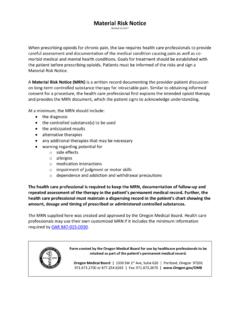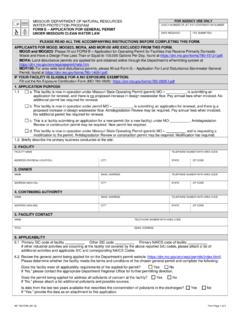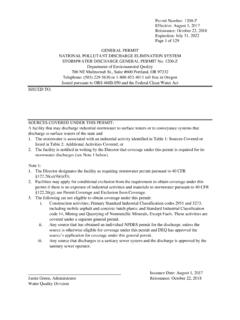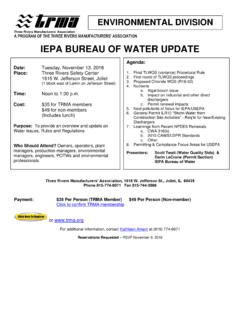Transcription of GENERAL PERMIT NATIONAL POLLUTANT DISCHARGE …
1 PERMIT Number: 1200-C. Expiration Date: December 14, 2020. Page 1 of 30. GENERAL PERMIT . NATIONAL POLLUTANT DISCHARGE elimination system . STORMWATER DISCHARGE PERMIT . Oregon Department of Environmental Quality 811 SW Sixth Avenue, Portland OR 97204. Telephone: (503) 229-5279 or 1-800-452-4011 (toll free in Oregon). Issued pursuant to ORS and Section 402 of the Federal Clean Water Act REGISTERED TO: SOURCES COVERED BY THIS PERMIT : The legally authorized representative (see Definitions) for construction activities (as defined below) that may DISCHARGE to surface waters or conveyance systems leading to surface waters of the state must register for coverage under this PERMIT with DEQ before any land disturbance occurs, unless the construction activities are automatically covered as described in the 1200-CN PERMIT . Construction activities including clearing, grading, excavation, materials or equipment staging and stockpiling that will disturb one or more acres and may DISCHARGE to surface waters or conveyance systems leading to surface waters of the state.
2 Construction activities including clearing, grading, excavation, materials or equipment staging and stockpiling that will disturb less than one acre that are part of a common plan of development or sale if the larger common plan of development or sale will ultimately disturb one acre or more and may DISCHARGE to surface waters or conveyance systems leading to surface waters of the state. This PERMIT also authorizes discharges from any other construction activity (including construction activity that disturbs less than one acre and is not part of a common plan of development or sale) designated by DEQ, where DEQ makes that designation based on the potential for contribution to an excursion of a water quality standard or for significant contribution of pollutants to waters of the state. This PERMIT does not authorize the following: In-water or riparian work, which is regulated by other programs and agencies including the Federal Clean Water Act Section 404 PERMIT program, the Oregon Department of State Lands, the Oregon Department of Fish and Wildlife, the Fish and Wildlife Service, the Army Corp of Engineers, the NATIONAL Marine Fisheries Service, and the Department of Environmental Quality Section 401 certification program.
3 Post-construction stormwater discharges that originate from the site after completion of construction activities and final stabilization. Discharges to underground injection control (UIC) systems. _____ Effective: December 15, 2015. Lydia Emer, Operations Administrator Expiration Date: December 14, 2020. PERMIT Number: 1200-C. Expiration Date: December 14, 2020. Page 2 of 30. PERMITTED ACTIVITIES. Until this PERMIT expires, is modified or revoked, the PERMIT registrant is authorized to construct, install, modify, or operate erosion and sediment control measures and stormwater treatment and control facilities, and to DISCHARGE stormwater and certain specified non-stormwater discharges to surface waters of the state or conveyance systems leading to surface waters of the state only in conformance with all the requirements, limitations, and conditions set forth in the PERMIT including attached schedules as follows: Unless specifically authorized by this PERMIT , by regulation issued by EPA, by another NPDES PERMIT , or by Oregon Administrative Rule, any other direct or indirect DISCHARGE to waters of the state is prohibited, including discharges to an underground injection control system .
4 PERMIT Number: 1200-C. Expiration Date: December 14, 2020. Page 3 of 30. Table of Contents SCHEDULE A CONTROLS AND LIMITATIONS .. 4. 1. Registering New Construction Activities .. 4. 2. Renewal Application for PERMIT Coverage .. 4. 3. Transfer of PERMIT Registration .. 5. 4. Authorized Stormwater Discharges .. 5. 5. Authorized Non-Stormwater Discharges .. 5. 6. Prohibited Discharges .. 6. 7. Control Measures .. 6. 8. Implementation of Control Measures .. 9. 9. BMP Maintenance .. 11. 10. In-stream Water Quality Standards .. 11. 11. Water Quality Requirements for TMDL and 303(d) Listed Waterbodies .. 11. 12. Erosion and Sediment Control Plan (ESCP) .. 12. 13. Corrective Actions .. 14. SCHEDULE B MINIMUM MONITORING AND RECORDKEEPING REQUIREMENTS .. 16. 1. Visual Monitoring .. 16. 2. Recordkeeping .. 17. SCHEDULE D SPECIAL CONDITIONS .. 18. 1. Schedule 18. 2. Other Requirements .. 18. 3. Termination of PERMIT Registration .. 18. 4. Local Public Agencies Acting as DEQ's Agent .. 19. 5.
5 PERMIT -Specific Definitions .. 19. SCHEDULE F NPDES GENERAL CONDITIONS INDUSTRIAL FACILITIES .. 22. SECTION A. STANDARD CONDITIONS .. 22. SECTION B. OPERATION AND MAINTENANCE OF POLLUTION CONTROLS .. 23. SECTION C. MONITORING AND RECORDS .. 26. SECTION D. REPORTING REQUIREMENTS .. 28. SECTION E. DEFINITIONS .. 30. PERMIT Number: 1200-C. Expiration Date: December 14, 2020. Page 4 of 30. SCHEDULE A. CONTROLS AND LIMITATIONS. CONSTRUCTION ACTIVITIES REQUIRED TO REGISTER FOR PERMIT . 1. Registering New Construction Activities a. Applicants seeking registration for coverage under this PERMIT for construction activities that will disturb one or more acres must submit a complete application to DEQ or Agent at least thirty (30). calendar days before the planned land disturbance, unless otherwise approved by DEQ or Agent (see Schedule D for description of Agent). The application must include: i. One paper copy and one electronic copy of the following: (1) A complete DEQ-approved application form.
6 (2) An Erosion and Sediment Control Plan (ESCP);. (3) A Land Use Compatibility Statement (LUCS) indicating that the proposed activities are compatible with the local government's acknowledged comprehensive plan; and ii. Applicable PERMIT fees. b. Applicants seeking registration for coverage under this PERMIT for construction activities that will disturb less than one acre that are part of a larger common plan of development or sale must, at least thirty (30) calendar days before the planned land disturbance, submit to DEQ or Agent: i. A complete DEQ-approved application form;. ii. One copy of an ESCP that covers the individual lot(s); and iii. Applicable PERMIT fees. c. Applicants seeking registration for coverage under this PERMIT for construction activities that disturb or are likely to disturb five (5) or more acres over the life of the project, are subject to a 14-calendar day public review period before PERMIT registration is granted. The public review period will not begin if the application form or ESCP are incomplete.
7 D. DEQ or Agent will notify the applicant in writing if registration is approved or denied. PERMIT coverage does not begin until the applicant receives written notice that the registration is approved. If registration is denied or the applicant does not wish to be regulated by this PERMIT , the applicant may apply for an individual PERMIT in accordance with OAR 340-045-0030. e. Until termination has been approved by DEQ or Agent, PERMIT registrants for permitted activities that disturb one acre or more must pay an annual fee. f. Permitted activities for projects that disturb less than one acre and utilize the small lot fee structure are covered under the PERMIT for 2 (two) years. To continue coverage beyond 2 years, the PERMIT registrant must submit a DEQ-approved application form and (if needed) an updated ESCP; and pay the applicable PERMIT fee. 2. Renewal Application for PERMIT Coverage a. An owner or operator of construction activities registered under the 1200-C PERMIT that expires in 2015 must submit to DEQ or Agent a complete renewal application, using a DEQ-approved renewal application form before expiration of the 1200-C PERMIT to ensure uninterrupted PERMIT coverage for construction stormwater discharges.
8 B. If renewal is denied or the applicant does not wish to be regulated by this PERMIT , the registrant may apply for an individual PERMIT in accordance with OAR 340-045-0030. PERMIT Number: 1200-C. Expiration Date: December 14, 2020. Page 5 of 30. 3. Transfer of PERMIT Registration a. To transfer PERMIT registration, the new owner or PERMIT registrant must submit a DEQ-approved transfer form and applicable fees prior to PERMIT expiration and within thirty (30) calendar days of the planned transfer. b. If ownership changes (through sale, foreclosure or other means) and the previous owner cannot be found: i. The new owner must register for coverage under the PERMIT (Schedule A, Paragraph 1) if the site is not stabilized. ii. The new owner must register for coverage under the PERMIT (Schedule A, Paragraph 1) prior to any additional land disturbance. iii. The new owner does not need to register for coverage under the PERMIT if the site meets the conditions for termination (see Schedule B) and there is no ongoing or additional land disturbance planned.
9 Iv. DEQ will attempt to contact the previous owner at the address on record. If there is no response, after sixty (60) calendar days DEQ may terminate the previous owner's PERMIT coverage. 4. Authorized Stormwater Discharges Subject to compliance with the terms and conditions of this PERMIT , and provided that all necessary controls are implemented to minimize sediment transport, the following stormwater discharges from construction sites are authorized (unless otherwise prohibited by local ordinances): a. Stormwater associated with construction activity described in the Sources Covered section of the PERMIT . b. Stormwater from support activities at the construction site (for example, concrete or asphalt operations, equipment staging yards, material storage areas, excavated material disposal areas and borrow areas) provided: i. The support activity is directly related to the construction site covered by this NPDES PERMIT ;. ii. The support activity is not a commercial operation serving multiple unrelated construction projects by different PERMIT registrants.
10 Iii. The support activity does not operate beyond the completion of the construction activity at the last construction project it supports; and iv. Appropriate control measures are used to ensure compliance with DISCHARGE and water quality requirements. 5. Authorized Non-Stormwater Discharges If the terms and conditions of this PERMIT are met, all necessary controls are implemented to minimize sediment transport, the DISCHARGE is not contaminated, and the DISCHARGE is not prohibited by local ordinance, the following non-stormwater discharges from construction sites are authorized: a. Water from emergency firefighting activities;. b. Fire hydrant flushings;. c. Potable water including water line flushing;. d. Vehicle washing and external building washing that does not use solvents, detergents or hot water;. e. Pavement wash waters where stockpiled material, spills or leaks of toxic or hazardous materials have not occurred (unless all stockpiled and spilled material has been removed) and where solvents, detergents or hot water are not used.















